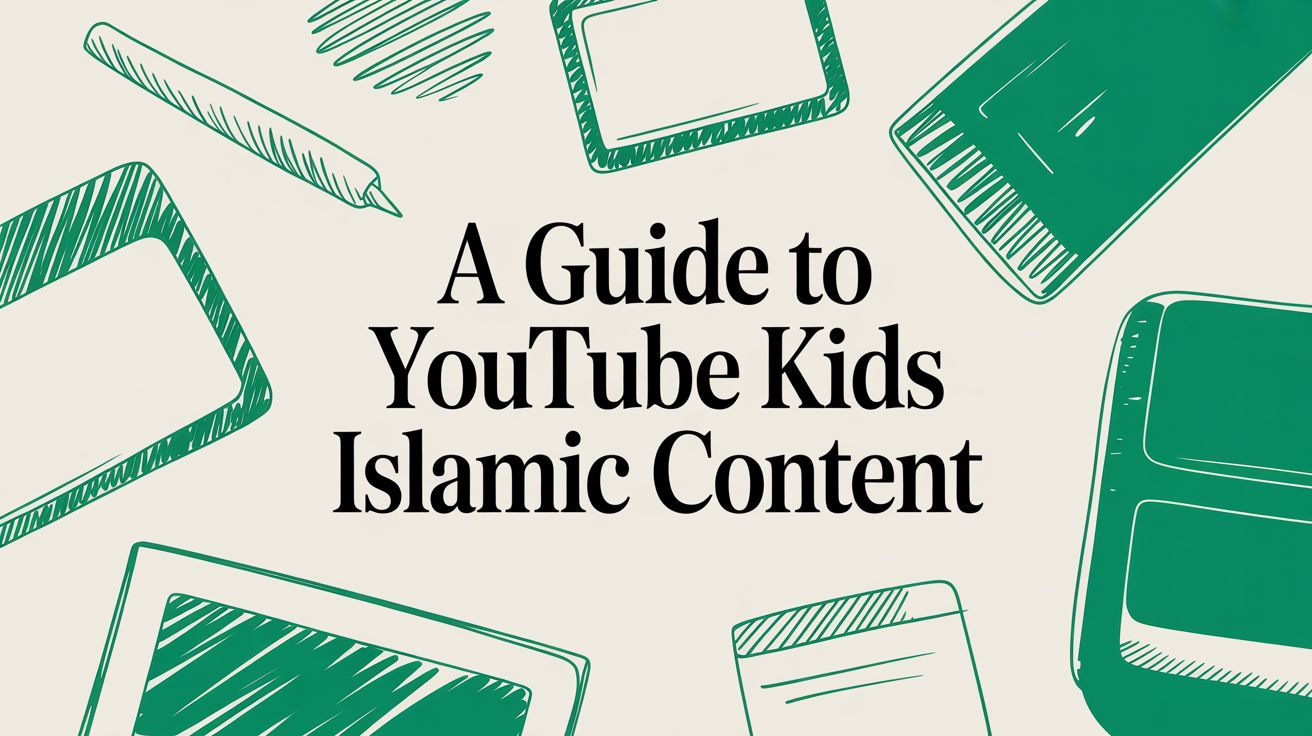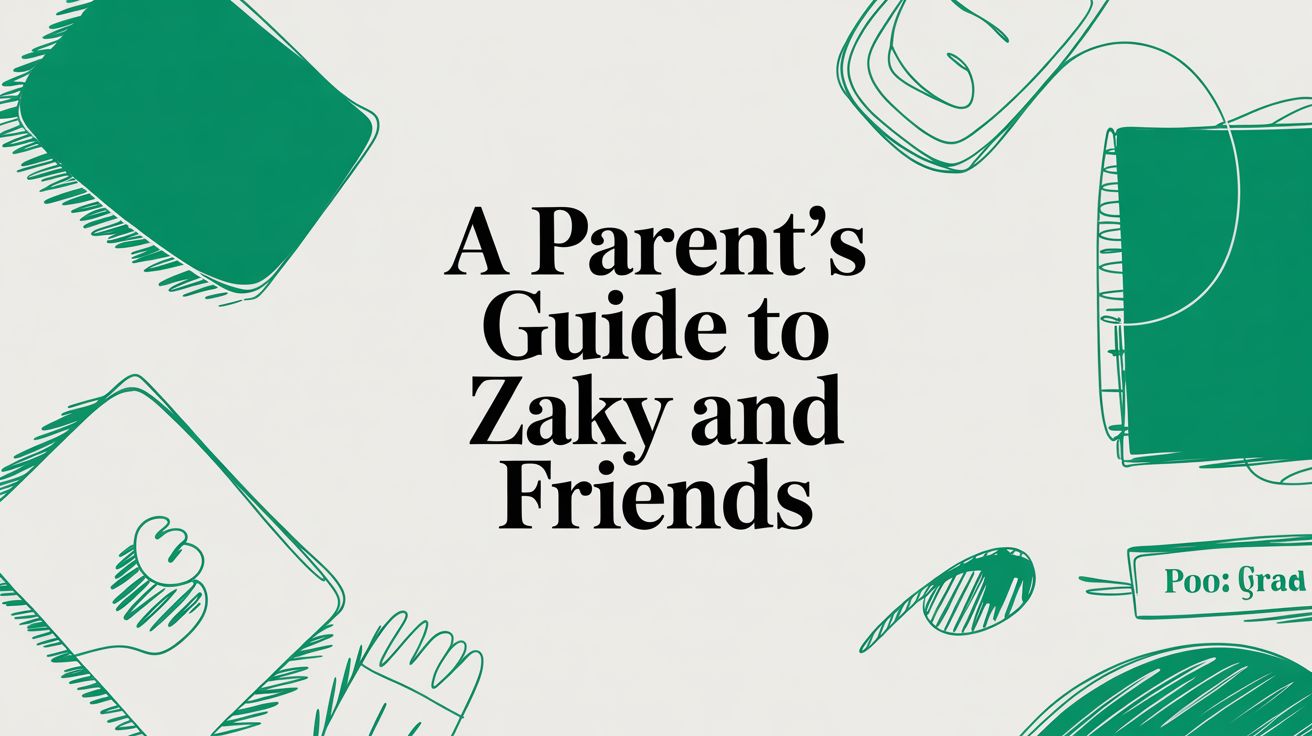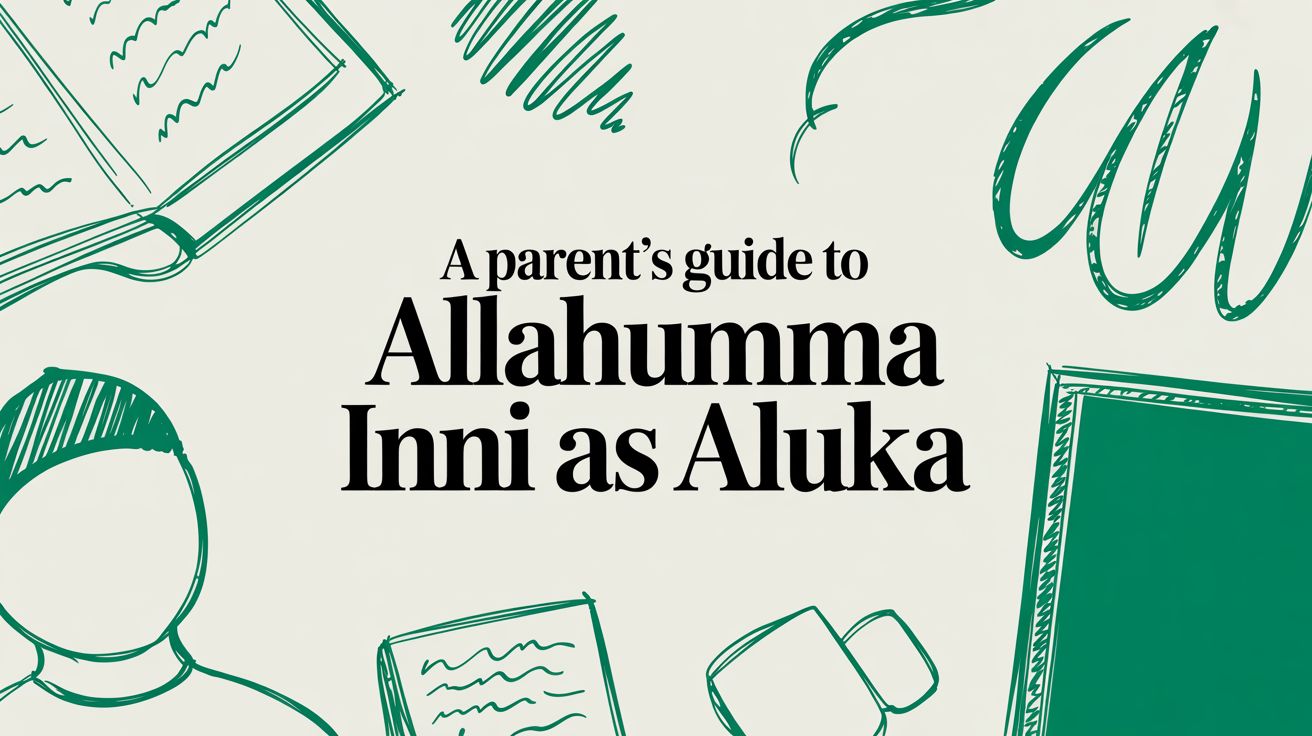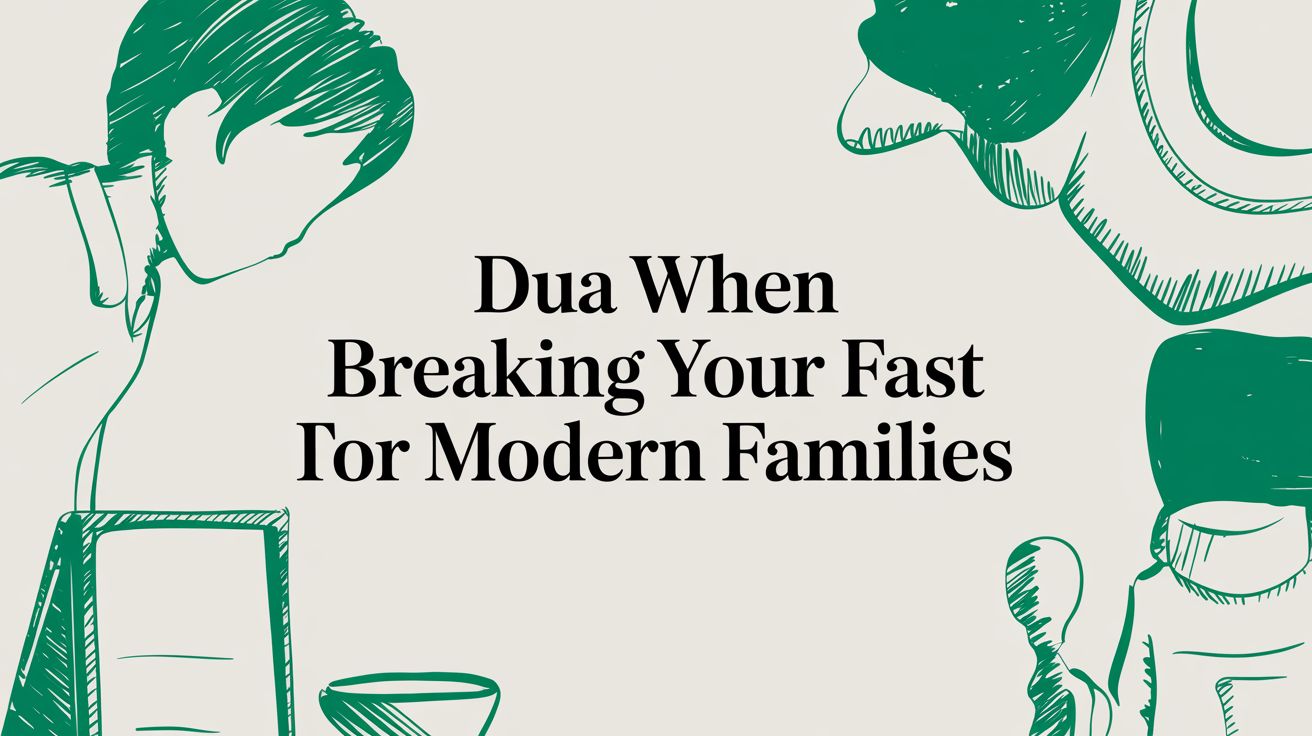As a Muslim parent, you know the juggle is real. Finding just ten minutes to prepare a meal, pray Asr, or jump on a work call feels like a monumental task with a curious toddler underfoot. Reaching for your phone and typing "YouTube Kids Islamic" seems like a quick fix, but that nagging worry—what might auto-play next?—is always in the back of your mind.
The secret isn't to avoid the app altogether, but to use it with intention. You can transform it from an algorithmic wild card into a safe, curated space you control completely.
Finding Peace of Mind in a Digital World
Let's be real: screen time often comes with a side of guilt. You get a much-needed moment of peace, but then wonder if you're exposing your child to something that doesn't align with your family's Islamic values. This is exactly why knowing the difference between the main YouTube app and YouTube Kids is so crucial.
Think of it like this: the standard YouTube app is a vast, open ocean. YouTube Kids, on the other hand, is meant to be a walled garden. But even the safest garden needs a little tending from you.
This guide isn't about promoting more screen time. It's about making the time you do use work for your family—transforming it from a digital babysitter into a genuinely helpful tool. We'll walk through how to lock down YouTube Kids so it becomes a source of beneficial, halal-aligned content that can actually support your child’s development within the beautiful, busy rhythm of your Muslim home.
YouTube vs. YouTube Kids: A Quick Comparison for Muslim Parents
So, what's the real difference? It all boils down to control. The main YouTube platform is built for everyone, which means its content, ads, and algorithms are often completely inappropriate for young children. YouTube Kids was created specifically to give parents the tools to filter and manage what their kids see.
The table below breaks down the key distinctions.
| Feature | Standard YouTube | YouTube Kids |
|---|---|---|
| Primary Audience | General (13+ years) | Children (Under 13) |
| Content Filtering | Limited community guidelines | Filtered by algorithms and human review |
| Parental Controls | "Restricted Mode" (basic) | Robust: profiles, timers, content approval |
| Advertisements | Unrestricted, often targeted | Strict ad policies; no food/drink ads |
| Key Feature | Massive content library | Approve Content Yourself mode |
As you can see, the Kids app is designed from the ground up with family safety in mind.
The real game-changer in YouTube Kids is the "Approve Content Yourself" setting. When you switch this on, you can hand-pick every single video and channel your child is allowed to watch. This one feature transforms the app from a passive, unpredictable stream into your family's private, halal video library.
The world of Islamic content has grown immensely. Over the past 20 years, YouTube has become the default video platform worldwide, and for many Muslim families, it's the main way Islamic educational content reaches them. This boom represents a massive shift in how we share our deen with the next generation. You can learn more about the evolution of Islamic content on YouTube to understand this trend.
Ultimately, you wouldn't let your toddler wander alone through a massive, bustling souq. You’d hold their hand and guide them straight to the stalls you know and trust. YouTube Kids, when configured correctly, lets you do the digital version of that—creating a safe, predictable, and enriching path for your little one to explore.
Alright, let's get practical. How do you actually turn the standard YouTube Kids app into a safe, halal space for your little one? It’s much easier than you might think, and these steps put you in complete control, ensuring every video aligns with your family’s values. This is how you go from feeling overwhelmed by endless videos to feeling peaceful and intentional about screen time.
This isn't about reacting to whatever the algorithm throws at you; it's about proactively creating a calm, controlled environment.
Your first move is to create a dedicated profile for your child. The moment you open the YouTube Kids app for the first time, it’ll walk you right through the process.
This is the welcome screen you'll see. It’s the gateway to building a digital space that truly fits your family.
You'll be prompted to add your child's name and age. For our babies and toddlers aged 0–3, the best choice is the "Preschool" setting, which covers ages 4 and under. This immediately provides a solid first layer of filtering, keeping out content meant for older kids.
The Most Important Setting: Approve Content Yourself
While the age filter is a decent start, the real magic lies in one specific setting: "Approve content yourself." This is the key to creating a genuinely worry-free, halal-friendly experience.
When you flip this switch, you effectively lock the app down. Your child can only watch videos and channels that you have personally vetted and hand-picked.
Nothing new will ever pop up unless you add it. This puts you, not a mysterious algorithm, in the driver's seat. Think of it as packing a wholesome, nourishing lunchbox for your child instead of handing them cash for a vending machine.
To get this feature up and running:
- Find and tap the lock icon in the corner of the app.
- You'll need to enter your passcode or solve a quick math problem.
- Navigate to Settings and tap on your child's profile.
- Under "Content Settings," you'll see the option for "Approve content yourself." Select it.
Once you’ve done this, the app’s home screen will look completely empty. Don't panic! It’s now a blank canvas, ready for you to fill with beneficial, calming content. You can start searching for specific Islamic channels or videos, and with a simple tap, add them to your child’s approved library.
Why This Is a Game-Changer for Muslim Parents
Choosing "Approve content yourself" directly tackles the biggest source of anxiety for most parents: the auto-play feature. You’ll never have to worry that a beautiful nasheed will be followed by a chaotic cartoon with questionable music or characters.
This one setting is your peace of mind. It means no surprises. No iffy content. No videos that contradict the gentle Islamic values you’re trying to nurture. It takes just a few minutes to set up but saves you from countless hours of stress down the road.
This hands-on approach also makes you a more mindful consumer of media for your child. As you actively search for videos, you’ll quickly learn to spot the channels that produce high-quality, spiritually uplifting content. You become the curator of their first digital library, ensuring every story and song is one you feel truly good about. It’s a small investment of time for a massive return in confidence.
Discovering the Best Islamic Channels for Your Toddler
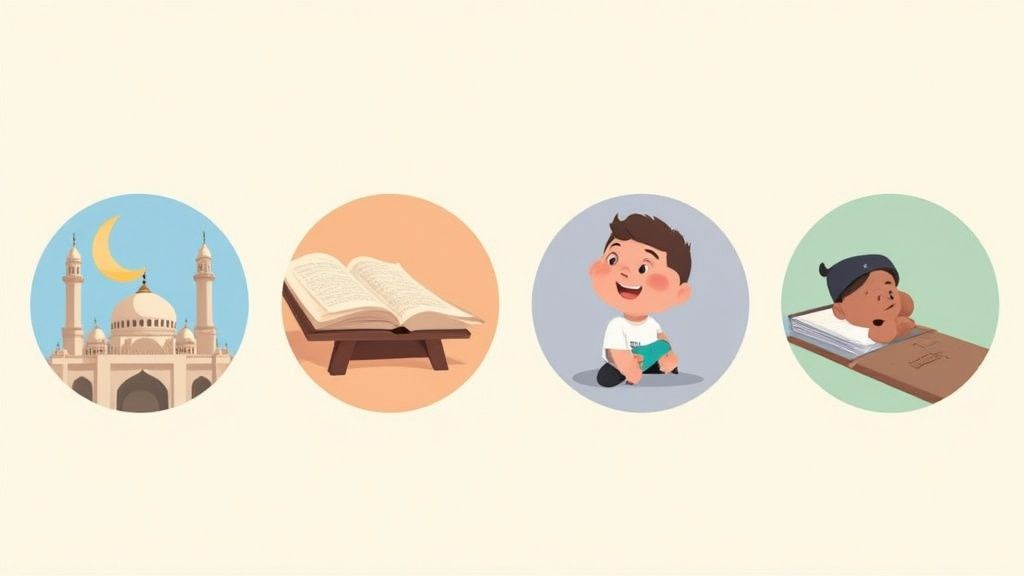
Now that you’ve created a secure, empty viewing space in YouTube Kids, the fun part begins: filling it with beautiful, beneficial content.
Our goal isn't just to find something to keep your little one occupied while you make wudu. It's about becoming a proactive curator, carefully choosing videos that serve as a gentle and positive first introduction to their deen.
You’re looking for content that feels calm, not chaotic. So many popular kids' shows, even ones labeled "educational," can be incredibly overstimulating for children under three. The loud music, frantic pacing, and bright, flashing colors are often too much for their developing nervous systems. For a deeper look at this, our guide on shows like Peppa Pig offers helpful insights into what to watch for.
Smart Searching on YouTube Kids
The key to finding great content is using specific, targeted search terms. Vague searches are a recipe for strange or low-quality results. To find the best YouTube Kids Islamic content, you have to think like a parent on a mission.
Instead of just typing "Islamic kids," try using more descriptive phrases:
- "Calm Islamic nursery rhymes" for gentle songs about daily routines.
- "Quran for babies sleep" to find soothing recitations perfect for naptime.
- "Simple adab for toddlers" for short stories about manners like saying Bismillah.
- "Arabic alphabet for toddlers" to find playful, slow-paced introductions to letters.
- "Nasheeds no music" or "Nasheeds with daff" depending on your family's preference.
These focused searches will help you zero in on channels dedicated to producing the kind of wholesome content you're looking for.
What Makes a Video Truly Toddler-Friendly?
As you start exploring, you'll quickly develop an eye for what works for your child. A video that captivates a three-year-old might be overwhelming for a one-year-old. That's why it's so important to preview content yourself before you approve it.
Before adding any video, watch at least a minute of it. Ask yourself: Is the tone gentle? Is the animation slow and simple? Is the message clear and positive? This simple habit is your most effective filter.
Thankfully, there’s been a wonderful growth of specialized Islamic YouTube channels just for children. Platforms like The Little Believers, Deenies, and Durioo (from the creators of Omar and Hana) are go-to sources for many parents. They're part of a larger movement to make Islamic learning engaging and accessible from the very beginning. You can find a great list of recommended channels for Muslim children to see just how much this space has grown.
A Quick Checklist for Vetting Islamic Videos
Evaluating content doesn't have to be a long, complicated process. When you find a promising video or channel, just run it through this quick mental checklist. It helps you stay consistent and feel confident in your choices.
Checklist for Vetting Islamic Videos for Toddlers
| Evaluation Criteria | What to Look For | What to Avoid |
| --- | --- | --- |
| Pacing and Animation | Slow, gentle movements and calm scene changes. Simple, clear visuals. | Fast-paced editing, flashing lights, and cluttered, busy scenes. |
| Audio and Music | Soothing vocals, gentle nasheeds, or clear, calm narration. | Loud, high-energy pop music, jarring sound effects, or chaotic dialogue. |
| Characters and Stories | Characters who model kindness, good manners (adab), and gentleness. | Characters who are sassy, rude, or engage in hyperactive or disrespectful behavior. |
| Islamic Message | Simple, foundational concepts like Allah's creation, saying Alhamdulillah, or loving the Prophet (PBUH). | Complex theological topics or content that could be confusing for a toddler. |
| Overall Feeling | Leaves you and your child feeling calm, happy, and spiritually connected. | Makes you feel anxious, overstimulated, or unsure about the message. |
This process turns you from a passive user into an empowered guide for your child's first media experiences. You’re ensuring the YouTube Kids Islamic content they see is not just "halal," but genuinely wholesome and beneficial for their tender hearts and minds.
It’s a small effort that builds a strong foundation for a positive relationship with their faith, one gentle video at a time.
Building a Healthy Screen Time Routine in Your Home

So, you've done the hard work of curating a beautiful library of YouTube Kids Islamic videos. That's a huge win! But the next piece of the puzzle is figuring out how to weave that content thoughtfully into your family’s daily rhythm.
Forget rigid, unforgiving rules. The real goal is to find a natural, predictable flow that makes screen time a helpful tool, not a constant source of friction. Think of it like mealtime or naptime—a defined part of the day with a clear beginning and end.
Using the Built-In Timer for Smooth Transitions
Let's be honest, the "just one more minute" negotiation with a toddler can test the patience of a saint. This is where the YouTube Kids built-in timer becomes your secret weapon. It's a simple tool, but it's brilliant for sidestepping those potential meltdowns.
When you set a timer, you create a clear, neutral boundary. The app itself announces when time is up and gently locks the screen. It’s the app ending the session, not you, which can depersonalize the whole transition and seriously reduce resistance.
Here's how that might look in real life:
* It's getting close to Asr, and you need a few minutes to get ready.
* You set the timer for 10 minutes while your toddler watches an approved nasheed.
* You give a simple heads-up: "Okay, habibi, we'll watch for a little bit. When the timer stops, we'll go get ready to pray together, insha'Allah."
This kind of predictability helps your child feel secure. They learn that screen time has a limit and that it doesn't end abruptly because they did something wrong.
The Power of Co-Watching and Connection
Even with the safest, most wholesome content, screen time is so much more powerful when it’s a shared experience. Co-watching—simply watching alongside your child—transforms a passive activity into an interactive, bonding moment.
You don't have to do it every single time, but even just a few minutes of shared viewing can make a world of difference. Plop down on the floor next to them and engage with what's on the screen.
- Watching a video about animals? Point and say, "Look, a qitah! A kitty! What does the kitty say?"
- Listening to a nasheed about saying Bismillah? Sing along and mime the action of eating.
- After a story about sharing, pull your child in for a hug and say, "That was so kind, just like you!"
This simple act of being present reinforces the positive Islamic messages in the videos and, most importantly, strengthens your connection. It also does wonders for their language development in a way that solo watching never could.
Co-watching turns screen time from a solo activity into a moment of connection. It's an opportunity to talk, cuddle, and reinforce the gentle Islamic values you see on screen, making them real and relatable for your child.
Integrating Screens into Your Daily Muslim Life
The key here is to make screen time fit your life, not the other way around. Think about the natural pauses in your day where a short, calming video could be a genuine help rather than just a distraction.
Here are a few practical ideas:
* Bedtime Wind-Down: A five-minute video of a slow, calming nasheed or a gentle Quran recitation can be a wonderful part of the bedtime routine, signaling that it’s time to settle down.
* Meal Prep Helper: While you're chopping vegetables for dinner before Maghrib, a short video about a family eating together can keep your toddler happily and safely occupied nearby.
* Quiet Time After Nursery: The stimulation of a busy day at a playgroup can be a lot for a little one. A familiar, gentle Islamic cartoon can help them decompress and transition into quiet time at home.
The right content can also be a great springboard for other types of play. For example, after watching a video about the Arabic alphabet, you might bring out some alphabet blocks. For more ideas on bridging the gap between digital concepts and physical play, our article on cause and effect toys has some great inspiration. By tying on-screen learning to real-world objects, you help cement those important connections in your child’s developing brain.
Exploring Safer Ad-Free Alternatives
https://www.youtube.com/embed/xeL47Zb-AJk
Even when you've locked down every setting, YouTube Kids is still YouTube. It’s a platform fundamentally built on ads and algorithms, and for many Muslim parents, that’s a real concern. You can do everything right—meticulously approving every video—only to have a little banner ad for a sugary snack or a new toy pop up, completely derailing the moment.
It’s no surprise that a growing number of families are turning to dedicated, subscription-based streaming services made just for Muslim kids. These platforms offer a totally different approach. Peace of mind is built in from the start, not something you have to constantly manage through settings.
What You Gain with a Curated Muslim Platform
The biggest benefit of a paid alternative isn't what it adds, but what it takes away. No ads. Ever. No sneaky product placements, no sidebar suggestions trying to sell you something, and no algorithm nudging your child toward the next loud, chaotic video that happens to be trending.
Instead, every single piece of content has been thoughtfully created or hand-picked by a team working within a specific educational and Islamic framework. This offers a level of safety that's hard to match.
I like to think of it as the difference between a huge public library and a small, curated Islamic bookstore for children. Both have books, sure. But one is designed with a specific purpose and set of values, ensuring every single item on the shelf is appropriate and beneficial for its audience.
These services provide a sense of trust that a massive, algorithm-driven platform like YouTube just can't replicate. The entire environment is a safe, walled garden from the moment you log in.
Thinking Through the Trade-Offs
Of course, the most obvious difference is the cost. Subscription services come with a monthly or annual fee, while YouTube Kids is free. That’s a real, practical consideration for any family, and it’s important to weigh the benefits against your budget.
Here’s a quick breakdown to help you think through the decision:
- Peace of Mind: With a paid service, the content has already been vetted for you by people who share your values. This saves you an incredible amount of time and the mental load of constantly searching, previewing, and approving videos.
- Content Alignment: These platforms are often built around a holistic Islamic curriculum. They cover everything from the Arabic alphabet and adab (manners) to stories of the prophets, all in an engaging, age-appropriate way.
- Privacy: Many dedicated services put a high value on user privacy. They aren't built on the data-tracking and profiling models that are essential to free, ad-supported platforms.
- Supporting Creators: Your subscription fee directly funds the creation of high-quality Islamic content. You're helping build a sustainable ecosystem for talented Muslim animators, storytellers, and educators.
This move toward specialized digital content is part of a larger shift in how we pass on our faith. As Muslim families have become smaller, the responsibility for religious education has moved from large, extended families to more focused resources like these platforms.
A dedicated, ad-free platform isn't just about avoiding bad content; it's about actively choosing a positive, nurturing, and spiritually enriching environment designed with your child's heart and mind as the top priority.
For families who want to feel confident that every minute of screen time is beneficial and 100% worry-free, exploring these alternatives is a great next step. They offer a predictable, calm, and trustworthy alternative to the often-unpredictable world of YouTube Kids Islamic content. It's also worth remembering that the best resources often incorporate diverse learning methods. For instance, you can find stories that teach the alphabet while also gently introducing sign language—you can read more about this in our guide to ABC stories using ASL. Ultimately, choosing the right digital tools is about finding what best supports your family’s unique journey.
Common Questions from Muslim Parents
Let's be honest, figuring out screen time for our little ones can feel overwhelming. You want to make the right choices for your family's values, and it's completely normal to have a million questions buzzing in your head.
Here are some of the most common concerns I hear from other Muslim parents, along with clear, reassuring answers. My hope is to give you the confidence to use these tools in a way that feels right for your home, insha'Allah.
Is YouTube Kids Really Safe for My Toddler?
This is the big one, isn't it? The most straightforward answer is: it’s a whole lot safer, but it's not perfect right out of the box. YouTube Kids does use algorithms and human checks to filter out inappropriate content, but things can and do slip through the cracks. The sheer volume of videos going up every single minute makes a 100% foolproof system nearly impossible.
This is precisely why the "Approve content yourself" mode is a game-changer.
When you switch this on, you're no longer relying on a robot to make decisions for your child. You're relying on your own judgment. You essentially create a completely closed-off digital space—a ‘walled garden’—where your child can only watch the specific videos and channels you have personally vetted and approved. This one step gives you total control and is the most effective way to guarantee a truly safe viewing experience.
Think of it this way: standard YouTube Kids is like a pre-packaged box of fruit from a massive supermarket. Most of it is probably fine, but you might find a bruised apple. "Approve content yourself" mode is like going to the farmer's market and hand-picking every single piece of fruit yourself. You know exactly what you’re getting.
How Do I Block a Video or Channel I Don’t Like?
Even with filters, you'll inevitably stumble upon a video or channel that just doesn't sit right with you. Maybe the animation is too chaotic, the characters are a bit sassy, or the message just doesn't align with the gentle, Islamic values you're trying to nurture.
Blocking this content is thankfully simple and immediate.
Here’s how to do it right in the app:
1. While a video is playing, tap the screen.
2. Look for the three vertical dots (the menu icon) and tap it.
3. A small menu will pop up. Just select "Block."
4. You’ll then get two choices: "Block this video" or "Block entire channel."
If you get a feeling you won't like the channel's overall style, blocking the whole thing is usually the most efficient move. It instantly removes it from your child's world, and they won't be able to stumble upon it again. It's a powerful little tool for fine-tuning their library and keeping your peace of mind.
How Can I Stop Screen Time Without the Tantrums?
Ah, the dreaded end of screen time. For a toddler, switching from a captivating video back to the real world can feel jarring, and that often leads to a meltdown. The secret is to make these transitions gentle, predictable, and positive.
Instead of just snatching the device away, try weaving these gentle strategies into your routine:
- Use the Built-in Timer: This feature is your best friend. The app itself announces that time is up, which means you don't have to be the "bad guy." It establishes a neutral, non-negotiable boundary.
- Give Verbal Countdowns: A little heads-up works wonders. A few minutes before it ends, you can say, "Okay, five more minutes until we finish our video and build with our blocks!" Then repeat it at "Two more minutes!" This helps your child mentally prepare for what's coming next.
- Have an Engaging Next Activity Ready: It’s so much easier for a child to move towards something fun than to just move away from the screen. Have their favorite puzzle, a sensory bin, or some play-doh ready to go. Try saying, "When this nasheed is over, it’s time to play with bubbles!"
By making the end of screen time a predictable and positive part of their day, you can dramatically reduce the chances of a tantrum. It helps your child see screen time for what it is—just one small, enjoyable part of their big, wonderful day.
At Babymode, we believe peace of mind shouldn’t require constant management. That's why we're building a 100% halal, ad-free streaming service where every video is safe, gentle, and aligned with your values from the start—no blocking or vetting required. Join the waitlist to learn more.
